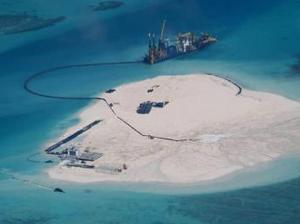China syndromeChina creates artificial lands in disputed waters to boost sovereignty claims
The Chinese government has been implementing a policy of creating new islands on the reefs and shoals of the South China Sea in order to further Chinese territorial claims to the area and increase sea-based infrastructure. By moving sand and other building materials onto these very shallow reefs, such as the Spratly archipelago, new islands are formed which officials say will eventually support buildings, humans, and surveillance equipment. According to the United Nations Convention on the Law of the Sea, by creating the lands, China will have economic rights within a 200 mile zone of each location.

Artficial islands being by China in process // Source: china.com.cn
The Chinese government has been implementing a policy of creating new islands on the reefs and shoals of the South China Sea in order to further Chinese territorial claims to the area and increase sea-based infrastructure.
As theNew York Times reports, by moving sand and other building materials onto these very shallow reefs, such as the Spratly archipelago, new islands are formed which officials say will eventually support buildings, humans, and surveillance equipment.
The move has alarmed neighboring countries such as Vietnam and the Philippines, who have protested against China for the actions. Many see the move as a “eying a perch in Spratlys as part of a long-term strategy of power projection across the Western Pacific.”
According to the United Nations Convention on the Law of the Sea, by creating the lands, the country will have economic rights within a 200 mile zone of each location. U.S. Defense Secretary Chuck Hagel criticized the move in a recent speech.
China has responded to the chorus of criticism by claiming “indisputable sovereignty” over the islands, arguing further that Vietnam and the Philippines have also engaged in construction within the region to an even greater degree. Wi Shicun, president of the National Institute for South China Sea Studies, a Chinese government-linked group, said, “Our facilities are worse than those of both the Philippines and Vietnam. You see that Vietnam even has a soccer field.”
Those countries, however, were not involved in the wholesale creation of artificial islands, which can be seen as an evolution in the fight over territory — likely due to the country’s considerable expansion of wealth and GDP within the past decade. Carlyle Thayer, a professor of politics at the University of New South Wales in Australia, told the paper, “It’s changing the status quo, it can only raise tensions.”
China has been engaged in the construction of three to four islands — with one at the Johnson South Reef seized from Vietnam in 1988 — which are estimated to be about 20 to 40 acres each. Already, one contains a military installation.
Adding an additional mysterious element, recent digital sketches of intended structures raised eyebrows after being circulated by the Global Times, a state-sponsored Chinese newspaper, with no explanation.
